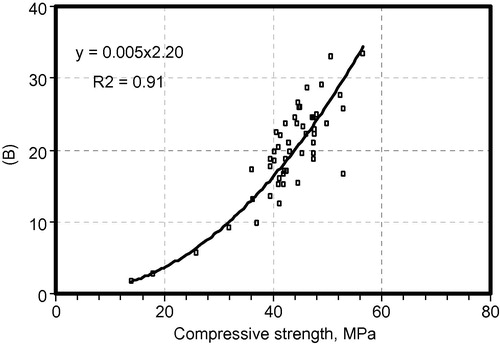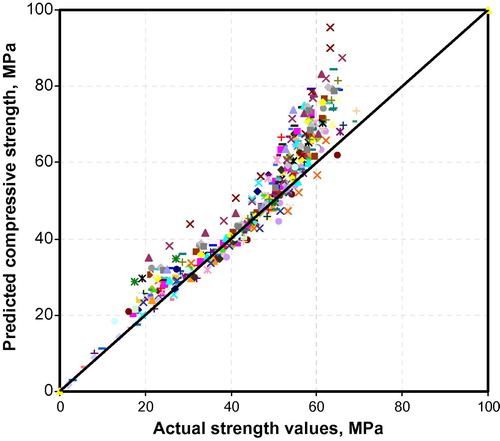 ?Mathematical formulae have been encoded as MathML and are displayed in this HTML version using MathJax in order to improve their display. Uncheck the box to turn MathJax off. This feature requires Javascript. Click on a formula to zoom.
?Mathematical formulae have been encoded as MathML and are displayed in this HTML version using MathJax in order to improve their display. Uncheck the box to turn MathJax off. This feature requires Javascript. Click on a formula to zoom.Abstract
Based on the existing experimental data for compressive strength values of different concrete mixes, a statistical analysis for the gathered data was conducted. The analysis revealed a model for predicting the compressive strength of concrete mixes at any age with the help of two constants (A) and (B) that are considered as a characteristic property for a concrete mix. The constant (A) is introduced as a rate of strength gain constant whereas, (B) is introduced as grade of strength constant.
Once the values of constants (A) and (B) are defined for a concrete mix, the compressive strength at any age could be simply predicted without collecting data at that age. The values of (A) and (B) could be determined by one of two methods. Solving two simultaneous equations at two different ages while performing either design or trial concrete mix is a method that could be used to define the two constants. Other method is based on concrete strength at 28-day age. The proposed model was studied for different concrete mixes. The study covered some parameters including the influence of, mineral admixtures as a partial replacement of cement, metakaolin, nano silica fume, curing in water or lime and the effect of curing temperature.
The analysis reveals that mixes containing no admixtures, mixes containing silica fume and cured at normal temperature, mixes containing nano silica and cured in water are following with high accuracy the proposed model.
Introduction
Compressive strength of concrete is one of the most important and useful properties. As a construction material, concrete is employed to resist compressive stresses. While, at locations where tensile strength or shear strength is of primary importance, the compressive strength is used to estimate the required property.
Common trend in concrete technology is to use compressive strength as a quantitative measure for other properties of hardened concrete [Citation1].
It is well known that, immediately after mixing cement based materials, the hydration process takes place. CSH is the compound resulting from hydration and it gives concrete its strength.
Cement based materials develop strength with continued hydration. The rate of gain of strength is faster at start and the rate gets reduced with age [Citation1]. In spite of considering the 28-day compressive strength for design purposes, actually concrete develops strength beyond 28 days as well. Most codes of practice do not consider the increase of strength beyond 28 days for design purposes [ACI [Citation2], ECP [Citation3], …].
British code gives modification factors for permissible compressive strength as 1.0, 1.10, 1.16, 1.2 and 1.24 for 1, 2, 3, 6, and 12 months as minimum age of member when full design load is applied whereas, for high strength concrete, British code allowed to add 0, 4.2, 5.5, 7.7 and 10.2 MPa over the permissible strength at 28 days for 1, 2, 3, 6 and 12 months, respectively.
Many a time it may be necessary to estimate the strength of concrete not only at an early age but also at later ages [Citation1]. Many research workers have attempted to estimate the strength of concrete at 1, 3 or 7 days and correlate to 28-day strength. Numerous research works have provided certain relationships. For instance;
In Germany, the relation between 28-day strength fc28 and the 7-day strength, fc7 is taken to lie between [Citation1],
Earlier ECP [Citation3] considered compressive strength gain as a parameter of age through the coefficients for ordinary Portland cement concrete strength as 0.4, 0.75, 1.0, 1.176 and 1.33 for 3, 7, 28, 90 and 360 days age, respectively. Whereas, for rapid strength Portland cement concrete those values were given as 0.556, 0.8363, 1, 1.111 and 1.176 for 3, 7, 28, 90 and 360 days, respectively. But with issuing the last version of ECP [Citation3], the coefficients considering the variation of compressive strength with age had been omitted.
In the history of concrete technology, Abrams’ formula [Citation4] was the first one describing the dependence of concrete strength on water cement ratio. Abrams suggested a mathematical relationship between concrete strength and water/cement ratio as:(3)
(3) where (fc) is the compressive strength of concrete; A and B are experimental parameters for a given age, material and curing conditions; and (x) is water/cement ratio by mass.
For an average Portland cement concrete cured under normal temperature and moisture, Abrams gave the relationship between compressive strength and water/cement ratio as [Citation5];(4)
(4) where, fc7 and fc28 are the strengths in MPa at 7 and 28 days, respectively. Moreover (x) is the water/cement ratio.
To consider the use of mineral admixtures in concrete, many studies have shown that when the water/binder ratio is used instead of water/cement ratio as basis for mix design; strength prediction becomes more accurate [Citation5,Citation6].
The water binder ratio takes the following shape;(5)
(5) where x is water/binder ratio; w is water content; c is cement content; f is fly ash content; s is granulated blast furnace slag (GBFS) content and k is an efficiency factor.
Beside Abrams’ formula, the power formula is considered as one of the most useful formulae in the field of concrete technology. It takes the following form [Citation4]:(6)
(6) where (fc) is the compressive strength; A and B are experimental parameters for a given age and x is the water/cement ratio.
Implementation of either Abrams’ formula or power formula to predict the concrete strength at any age requires collecting a lot of data at that age, then build a specific formula, and using a time factor (a function of age) multiplied by specific age strength (usually 28 – day strength) to estimate the strength at a given age.
Yeh [Citation7] proposed two novel methodologies, parameter – trend – regression and four – parameter – optimization methodology to extend Abrams’ formula and the power formula to any given age without collecting data at that age. The proposed model is a generalization of Abram, formula and the power formula, respectively, to be;(7)
(7) where (fc,t) is the concrete compressive strength at age t days; (At) and (Bt) are experimental parameters depending on age and (x) is the water/binder ratio [Citation7].
Early age strength prediction in concrete is very useful in reducing construction cost and ensuring safety. Furthermore, early age strength prediction has several practical applications. It can be used to determine safe stripping time, prestressing application or post – tensioning time, to monitor strength development, particularly when concreting in cold weather, to check serviceability conditions or compliance criteria, to ensure construction safety and, generally to estimate the quality of construction and potential durability [Citation8].
Moreover prediction of concrete strength at late ages is being significant from both technical and economical points of view. For instance, when considering the actual strength values at which the structure is being subjected to full load, materials safe could be achieved as considered by BS in the track of minimizing the pollution.
Concrete compressive strength is influenced by many factors including, water/cement ratio, cement content and properties, aggregate type and its properties, etc. This paper introduces a simple mathematical model that can help predicting the compressive strength for a specified concrete mix at any age with the help of two fixed constants indicating the mix. Those constants could be estimated by two different methods; the first method is based on solving two simultaneous equations at two different ages whereas, the second depends on compressive strength at 28-day age.
Suggested model
Abrams’ formula [Citation4] could be used to predict concrete strength at either 7 or 28 days only based on w/c ratio.
Yeh [Citation7] made a modification for Abrams’ formula to enable predicting concrete strength at any age. He proposed that concrete strength at any age depends on two constants that should be determined to predict the concrete strength at that age. The two constants should be first calculated at the required age.
King [Citation9] suggested a nonlinear correlation between accelerated strength and strength of concrete at age of 28 days.
Other methods were reported by Malhotra [Citation10] and Garino [Citation11] where they made a brief review of the four test procedures covered by ASTM C 684.
Standard practice for estimating concrete strength by the maturity method was introduced in ASTM C 1074-93 [Citation8]. In this method; both time and temperature could be used to approximate the combined effects of these two factors on strength development.
This paper introduces a simple and direct forward method to predict concrete strength with age. The proposed method introduces two constants describing the development of concrete strength at any age without collecting data at those ages. The development of the proposed model is explained as following.
Strength development for pure clinker minerals
The compressive strength development of pastes made of pure C3S, C2S, C3A and C4AF was studied [Citation12,Citation13]. The obtained results may be summarized as follows:
C3S exhibits fairly rapid short-time strength development and subsequent gradual strength increase for at least 1 year;
The initial strength development of C2S is sluggish, yet the strength increases gradually for at least 1 year and reaches reasonably high final values;
The strength of hydrated C3A is very low even after 1 year of hydration; C4AF exhibits a rapid short-term strength development but only a very moderate strength increase, or even a moderate strength decline later on. The results are plotted in a and b. a shows the relationship between age and compressive strength as a normal scale whereas, b presents the same relationship but on a semi-logarithmic scale.
Fig. 1 Relationship between compressive strength and age for clinker minerals and cement [Citation14]. (a) Normal scale and (b) log scale.
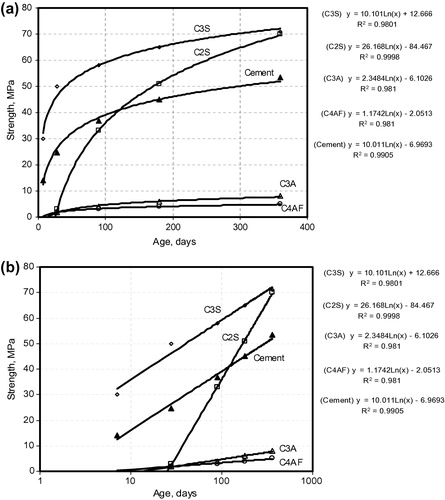
For all clinker minerals, the relationship between age and the compressive strength could be given as; Compressive strength = constant (A) ∗ ln(age) + constant (B) with correlation factors approaching unity.
It can be noticed that, for a given degree of hydration, the strength increases in the order C3A < C4AF < C2S < C3S, indicating the existing differences in the intrinsic strengths of hydrates formed in the hydration of different clinker minerals [Citation14].
For cements it was found that, for narrow ranges of clinker composition and a constant gypsum content and fineness, the existing composition-strength relationship may be expressed with an acceptable accuracy with an equation of the type as given in Eq. (Equation8(8)
(8) )[Citation14];
(8)
(8) where c1, c2, etc. are the contents of the phases C3S, C2S, C3A and C4AF in clinker and a0, a1, a2, a3 and a4 are constants (regression coefficients) whose magnitude depends also on the hydration time and the employed testing method. The previous equation is applied to a specified Portland cement depending on its composition and the relationship between age and strength is plotted in a and b. For the proposed cement composition, the strength development takes the same form for the pure clinker minerals as;
Strength development for Portland cement concrete
The Portland cement concrete strength level and rate of gain are dependent on many factors. Hydration rate and percentage are two factors related to the used cement. Besides the used cement, there are many factors contributing to both of strength level and its rate of gain at different ages. Mix composition, aggregate type and properties, temperature degree, curing time and method are some factors among the factors affecting both strength level and gain rate at different ages. The experimental results for Adnan [Citation15] are considered to investigate the relationship between age and strength of Portland cement concrete at normal temperature (20 °C).
a and b show the relationship between age and strength for concrete mixes containing w/c from 0.4 up to 0.9. Regression lines of the form ft = A ln(t) + B could be drawn for the given results with a correlation coefficient greater than 0.97.
Fig. 2 Relationship between compressive strength and age for concrete mixes [Citation15]. (a) Normal scale and (b) log scale.
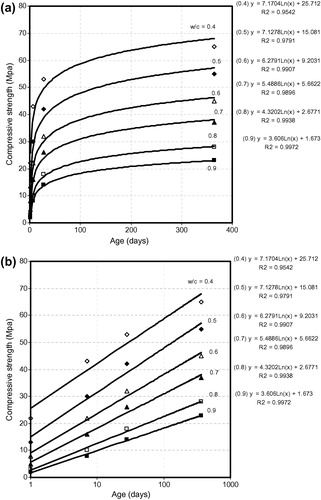
So, the relationship between age and compressive strength for concrete mixes could take the following shape:(9)
(9) where, (ft) is the compressive strength at age (t) days and (A) and (B) are constants.
Definition of constants A and B
Considering the regression equation for concrete strength with age as given in Eq. (Equation9(9)
(9) ), the value of constant (B) could be understood as the intersected part of the strength axis by the regression line. It changes from mix to other depending on the values of the compressive strength along with the age. That constant will be denoted as the level of strength constant (grade constant). Whereas, the constant (A) denotes the slope of the regression line that will be called rate of strength gain constant (rate constant).
Experimental data pertinent to values of compressive strength fc at different ages for a large number of concrete mixes are gathered from several research papers [Citation14–Citation[15]Citation16,Citation17,Citation18]. For each concrete mix, the compressive strength versus age is plotted then a regression curve is fitted of the form given in Eq. (Equation9(9)
(9) ) from which the values of the constants A and B are estimated. presents the raw data used in this study.
Table 1 Raw data from references [Citation14–Citation[15]Citation[16]Citation17,Citation18,Citation19].
Grade constant, B
The estimated (B) values are scattered versus the corresponding compressive strength at 28 day age in . A best fitting curve is drawn joining the results and takes the form(10)
(10) where, B is the grade constant and fc is the 28-day compressive strength.
Rate constant, A
The estimated regression data for (A) and (B) are scattered in . A best fitting curve for the scattered data is given as(11)
(11)
Based on Eqs. (Equation10andEquation11
(9)
(9) ) and beside the pre calculated values of (A) and (B), and show the calculated values versus the expected ones for constants (B) and (A), respectively. The predicted values seem to be in a well agreement with those calculated from actual strength results.
Fig. 5 Relationship between calculated B values versus predicted corresponding ones using Eq. (Equation10(10)
(10) ).

Fig. 6 Relationship between calculated (A) values versus predicted corresponding ones using Eq. (Equation11(11)
(11) ).
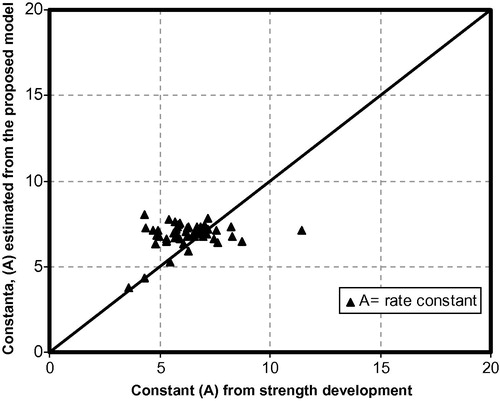
Application of the proposed model for Portland cement concrete mixes
The proposed model for the estimation of the concrete strength at different ages is applied to the data taken from the literature and given in as follows:
Based on the compressive strength at 28 days and employing Eq. (Equation10
(10)
(10) ) the grade constant (B) could be calculated from which using Eq. (Equation11
(11)
(11) ), the mean value for the rate constant (A) could be predicted.
Using the estimated constant values for (A) and (B), an equation representing the compressive strength at any required age could be established.
shows the relationship between the measured versus the estimated values for the compressive strength with age. The plotted data confirm the reliability of the proposed method for the estimation of the concrete compressive strength with age.
Applicability of the model for mixes containing mineral admixtures
shows the relationship between age and compressive strength for mixes containing 0%, 12%, 16%, 20%, 24% and 28% silica fume as a percentage replacement by cement mass [Citation17]. It could be noticed that the relationship between age and strength of all mixes containing silica fume can follow the same trend as given in Eq. (Equation9(9)
(9) ) with a correlation coefficient ranges between 0.9 and 1.0.
Fig. 8 Effect of using silica fume on strength development at 20 °C as per the proposed model [Citation17].
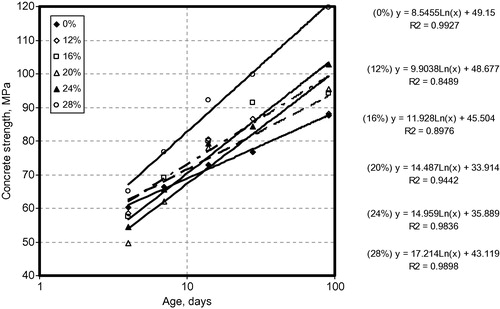
On the other hand, represents the relationship between age and compressive strength for concrete mixes containing 0%, 5%, 10%, 15%, 20%, 25% and 30% metakaolin as a replacement of cement mass [Citation19]. From regression lines, it could be noticed that the correlation coefficient for the regression lines is about 0.9. The values of the rate constant (A) seem to be increased with the increase of metakaolin content which reflects the influence of aging on approaching the final compressive strength for mixes containing metakaolin.
Fig. 9 Effect of using metakaolin on the development of compressive strength as per the proposed model [Citation19].
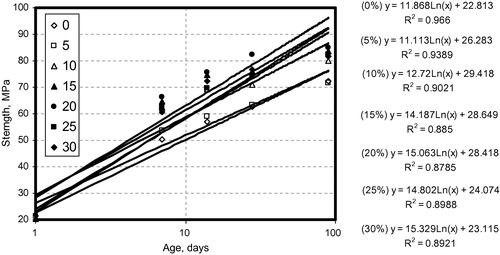
Applicability of the model to concrete mixes containing nano silica
The influence of nano silica fume on compressive strength of concrete mixes was studied [Citation16]. The effect of curing media was investigated. Two methods for curing including water and lime solution were applied. The results of compressive strength versus age are scattered in . It could be noticed that, for mixes containing 0%, 0.5%, 1.0%, 1.5% and 2.0% by cement mass and cured in water follow the proposed Eq. (Equation9(9)
(9) ) with a correlation coefficient more than 0.95. The values of coefficients (B and A) for mixes containing nano silica and cured in water seem to be greater than the corresponding ones for control mix. Whereas, for concrete mixes containing nano silica and cured in lime solution, the proposed equation represents the strength gain as a function of age with a correlation coefficient about 0.8. It could be noticed also that the values of constant (B) increase with the increase of the nano silica content in concrete mixes cured in lime solution.
Fig. 10 Effect of using nano silica in concrete mixes on the development of strength as per the proposed model [Citation16].
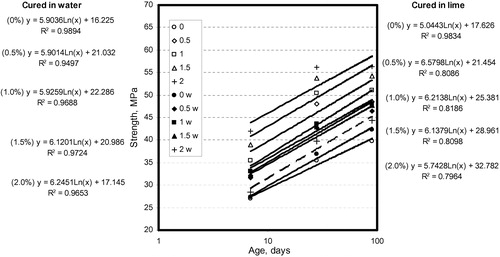
Applicability of the model to concrete mixes at high temperature
Results of Han and Kim [Citation18] were analyzed to investigate the influence of the temperature degree on the compressive strength development for Portland cement concrete. shows the relationship between age and compressive strength for concrete mixes prepared with w/c of 0.4 and 0.5 and type V cement at 10, 23 and 50 °C. The strength gain could be represented by regression lines as given in Eq. (Equation9(9)
(9) ) with relatively high correlation coefficients above 0.97. The values of the rate constant (A) are increased with reducing w/c ratios as well as at lower temperature degrees. On the other hand, the grade constant (B) tends to increase at high temperature degrees or with reducing of w/c ratio of the mix. The fast hydration process due to the high temperature influences clearly the values of the grade constant (B) whereas the values of the rate constant (A) reflect the required period to approach the final compressive strength.
Fig. 11 Effect of temperature degree on the strength development as per the proposed model [Citation18].
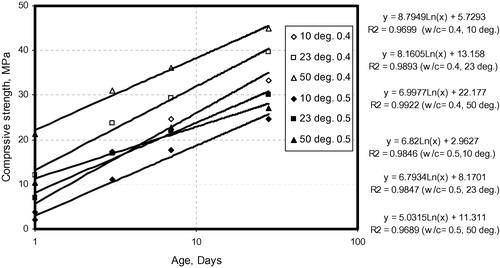
shows the age-compressive strength relationship for concrete mixes containing silica fume at 50 °C [Citation17]. Regression lines of the form proposed in Eq. (Equation9(9)
(9) ) could be drawn for each mix with varied correlation coefficient. It could be noticed that the values of grade constant (B) are higher compared to the corresponding values at 20 °C. The values of (B) constant tend to increase with the increase of silica fume content.
Fig. 12 Effect of temperature degree on the strength development at 50 °C as per the proposed model [Citation19].
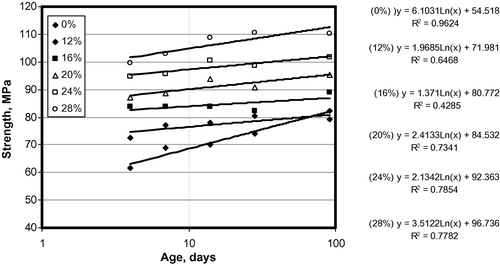
On the other hand and at 50 °C, the rate values (A) for control mix are greater than the corresponding values for mixes containing silica fume. Moreover, the (A) values tend to increase with the increase of silica fume content.
Out of this and based on (B) values, it could be concluded that, concrete mixes containing silica fume at 50 °C gain most of their strength at early ages. Moreover, the relatively smaller (A) values indicate the slower rate of strength gain at later ages due to the rapid hydration process.
Sample calculations
introduces a sample calculation and application for the proposed model for the estimation of Portland cement concrete strength with age. Firstly, and based on the characteristic strength at 28 days, mix constants (A) and (B) are calculated using Eqs. (Equation11(9)
(9) andEquation10
), respectively. Consequently, and using Eq. (Equation9
(9)
(9) ), the compressive strength could be predicted at any required age. Six concrete mixes that are previously conducted by Adnan [Citation15] are considered including different w/c ratios. The results of calculations are given in . Moreover the actually measured compressive strength values are plotted versus the corresponding predicted ones in . The predicted compressive strength values are in a good agreement with those previously measured by Adnan [Citation15].
Fig. 13 Actual compressive strength values versus predicted ones at different ages for sample calculation example.
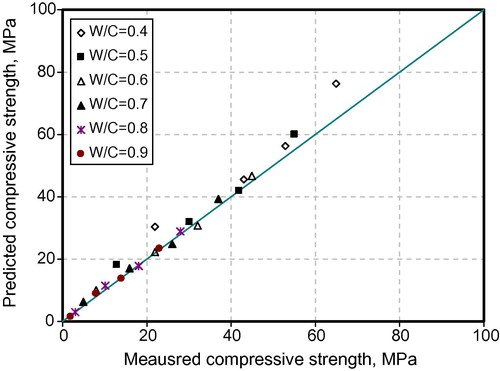
Table 2 Sample calculations.
Conclusions
Based on the analysis for the data gathered from the literature it could be concluded that:
| • | A mathematical model includes Eqs. (Equation– | ||||
| • | The proposed model can represent the strength development with age for Portland cement concrete mixes containing silica fume at normal temperature 20 °C. | ||||
| • | The proposed model could be used to estimate the compressive strength at any age for Portland cement concrete containing nano silica fume and cured in water at normal temperature 20 °C. | ||||
| • | The proposed Eq. (Equation9 | ||||
| • | Portland cement concrete mixes containing metakaolin or silica fume at high temperature and mixes containing nano silica fume particles and cured in lime solutions are not following the proposed model. | ||||
Notes
Peer review under responsibility of Housing and Building National Research Center.
References
- M.S.ShettyConcrete Technology Theory and Practice2006S. Chand & Company Ltd.New Delhi (Chapter 7)
- ACI 318–11, Building Code Requirements for Structural Concrete and Commentary.
- ECP 203Egyptian Code for Designing and Executing the Building Works2nd ed.2009HBRCEgypt
- A.DuffDesign of Concrete Mixtures Bulletin No. 11918Structural Materials Laboratory, Lewis InstituteChicagop.20
- F.A.OluokunFly ash concrete mix design and water–cement ratio lawACI Materials Journal9141994362371
- K.G.BabuG.S.N.RaoEfficiency of fly ash in concrete with ageCement and Concrete Research2631996465474
- C.YehGeneralization of strength versus water–cementitious ratio relationship to ageCement and Concrete Research36200618651873
- ASTM C 1074–93, Standard Practice for Estimating Concrete Strength by the Maturity Method.
- J.W.A.KingFurther Notes on the Accelerated Test for Concrete1957Chartered, Civil Engineering pp. 15–19
- V.M.MalhotraAccelerated strength testing is it a solution to a contractor’s dilemma?Concrete International319811721
- N. Garino, Tests and Properties of Concrete, ASTM STP 169C, 1994.
- J.J.BeaudoinV.S.RamachandranA new perspective on the hydration characteristics of cement phasesCement and Concrete Research2241992689694
- S.A. Mironov, L.A. Malinina, Accelerated Concrete Hardening (in Russian), International Transport Research Documentation (ITRD) (in English), Stroiizdat, Moscow, 1964.
- P.C.HewlettLea’s Chemistry of Cement and Concrete2005Elsevier Butterworth-HeinemannNew York (Chapter 6)
- A.ColakA new model for the estimation of compressive strength of Portland cement concreteCement and Concrete Research367200614091413
- A.GiviS.RashidF.AzizM.SallehThe effects of lime solution on the properties of SiO2 nanoparticles binary blended concreteComposites B4232011562569
- S.WildB.B.SabirJ.M.KhatibFactors influencing strength development of concrete containing silica fumeCement and Concrete Research257199515671580
- S.-H.HanJ.-K.KimEffect of temperature and age on the relationship between dynamic and static elastic modulus of concreteCement and concrete research347200412191227
- S.WildJ.M.KhatibA.JonesRelative strength, pozzolanic activity and cement hydration in supperplasticised Metakaolin concreteCement and Concrete Research2610199615371544

